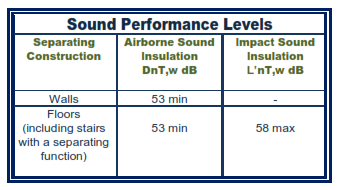Building Acoustics
Moloney & Associates Acoustic and Environmental Consultants Ltd. have been involved with testing the performance of walls and floors since 2004 and have acquired significant experience in the construction sector. With have acted as expert witnesses for engineers, architects and construction companies and have provided expert testimony in court cases where alleged acoustic defects were claimed. We have also acquired experience in remedial treatments where building defects have been remedied to ensure compliance.
Sound insulation tests are carried out in accordance with the following standards:
• ISO 16283-1: 2014 Acoustics — Field measurement of sound insulation in buildings and of building elements — Part 1: Airborne sound insulation
• ISO 16283-2: 2020, Acoustics — Field measurement of sound insulation in buildings and of building elements — Part 2: Impact sound insulation
ISO 16283-1:2014 specifies procedures to determine the airborne sound insulation between two rooms in a building. The test results can be used to quantify, assess and compare the airborne sound insulation. The measured airborne sound insulation is frequency-dependent and can be converted into a single number quantity to characterize the acoustic performance using the rating ISO procedures.
ISO 16283-2: 2020: deals with the field measurements of impact sound insulation of floors. The method specifies procedures to determine the impact sound insulation using sound pressure measurements with an impact source operating on a floor or stairs in a building. These procedures are intended for room volumes in the range from 10 m3 to 250 m3 in the frequency range from 50 Hz to 5000 Hz. The test results can be used to quantify, assess and compare the impact sound insulation in unfurnished or furnished rooms where the sound field may or may not approximate to a diffuse field.
Acoustic Noise Building Testing
The current requirements relating to building acoustics in the domestic property sector are provided for in the Building Regulations 2014 – Technical Guidance Document – Part E Sound.
One of the aims of Part E of the Second Schedule to the Building Regulations is to ensure that dwellings achieve reasonable levels of sound insulation from sound transmission emanating from adjoining buildings or differently occupied parts of the same building.

The current requirements relating to building acoustics in the domestic property sector are provided for in the Building Regulations 2014 – Technical Guidance Document – Part E Sound.
One of the aims of Part E of the Second Schedule to the Building Regulations is to ensure that dwellings achieve reasonable levels of sound insulation from sound transmission emanating from adjoining buildings or differently occupied parts of the same building.
In general for dwellings, the performance required by the regulations should be satisfied by achieving the sound insulation performance levels as specified in Table 1.
Table 1: Sound Performance Levels




